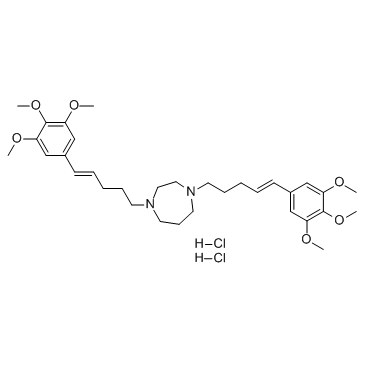| Cas No.: | 191089-60-8 |
| Chemical Name: | K-7174-2HCl |
| SMILES: | COC1C=C(C=CCCCN2CCCN(CCCC=CC3C=C(OC)C(OC)=C(OC)C=3)CC2)C=C(OC)C=1OC.[H]Cl.[H]Cl |
| Formula: | C33H50Cl2N2O6 |
| M.Wt: | 640.3 |
| Purity: | >98% |
| Sotrage: | 2 years -20°C Powder, 2 weeks 4°C in DMSO, 6 months -80°C in DMSO |
| Description: | K-7174 dihydrochloride is a novel cell adhesion inhibitor; inhibits the expression of vascular cell adhesion molecule-1 (VCAM-1) induced by either IL-1β or TNF-α. |
| Target: | GATA-specific inhibitor |
| In Vivo: | K-7174, one of proteasome inhibitory homopiperazine derivatives, exhibits a therapeutic effect, which is stronger when administered orally than intravenously, without obvious side effects in a murine myeloma model. Moreover, K-7174 kills bortezomib-resistant myeloma cells carrying a β5-subunit mutation in vivo and primary cells from a patient resistant to bortezomib [4]. |
| In Vitro: | K-7174 inhibited the expression of vascular cell adhesion molecule-1 (VCAM-1) induced by either tumor necrosis factor alpha or interleukin-1beta, without affecting the induction of intercellular adhesion molecule-1 or E-selectin. K-7174 had no effect on the stability of VCAM-1 mRNA.K-7174 did not influence the binding to any of the following binding motifs: octamer binding protein, AP-1, SP-1, ets, NFkappaB, or interferon regulatory factor [1]. Addition of 10 microM K-7174 rescued these inhibitions of Epo protein production and promoter activity induced by IL-1beta, TNF-alpha, or L-NMMA, respectively [2]. K-7174 had the potential to induce endoplasmic reticulum (ER) stress evidenced by induction of GRP78 and CHOP.Other inducers of ER stress completely reproduced the effects of K-7174 including suppression of lipid accumulation, blockade of induction of adiponection and PPARgamma and maintenance of MCP-1 expression [3]. |
| References: | [1]. Umetani M, et al. A novel cell adhesion inhibitor, K-7174, reduces the endothelial VCAM-1 induction by inflammatory cytokines, acting through the regulation of GATA. Biochem Biophys Res Commun. 2000 Jun 7;272(2):370-4. [2]. Imagawa S, et al. A GATA-specific inhibitor (K-7174) rescues anemia induced by IL-1beta, TNF-alpha, or L-NMMA. FASEB J. 2003 Sep;17(12):1742-4. [3]. Shimada T, et al. Unexpected blockade of adipocyte differentiation by K-7174: implication for endoplasmic reticulum stress. Biochem Biophys Res Commun. 2007 Nov 16;363(2):355-60. [4]. Kikuchi J, et al. The novel orally active proteasome inhibitor K-7174 exerts anti-myeloma activity in vitro and in vivo by down-regulating the expression of class I histone deacetylases. J Biol Chem. 2013 Aug 30;288(35):25593-602. |

 DC Chemicals' products qualify for U.S. tariff exemptions. We guarantee no price increases due to customs duties and maintain stable supply, continuing to deliver reliable research solutions to our American clients.
DC Chemicals' products qualify for U.S. tariff exemptions. We guarantee no price increases due to customs duties and maintain stable supply, continuing to deliver reliable research solutions to our American clients.





















